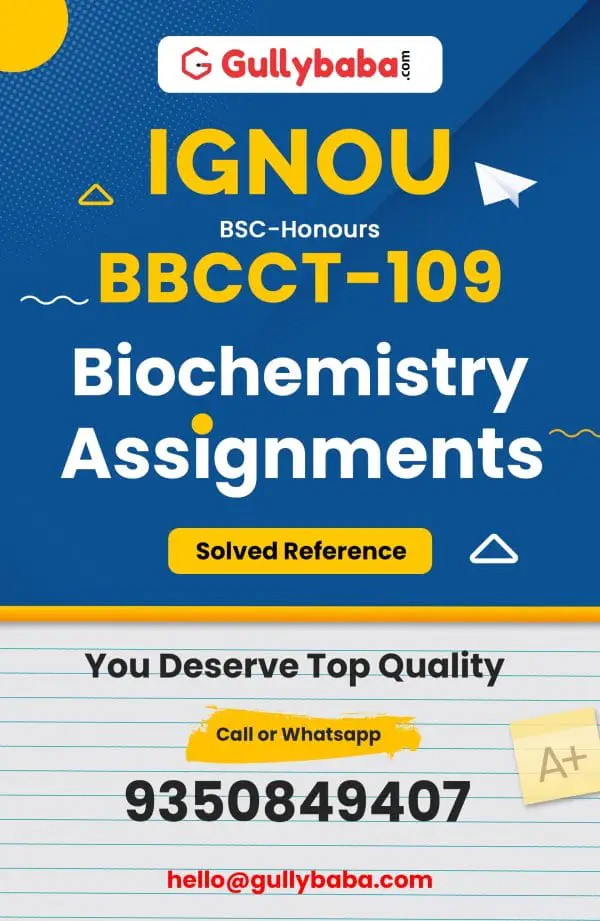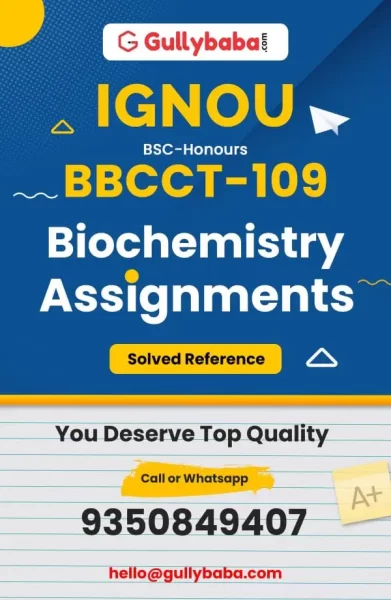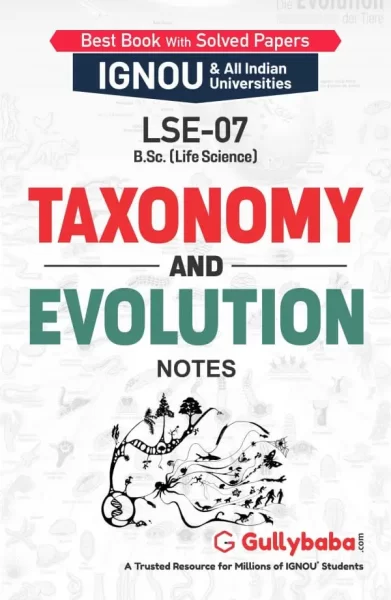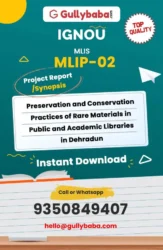PLEASE MATCH YOUR ASSIGNMENT QUESTIONS ACCORDING TO YOUR SESSION
IGNOU BBCCT-109 (January 2025 – December 2025) Assignment Questions
PART-(A)
1. Explain the terms in 2-3 sentences:
(a) Substrate level phosphorylation
(b) Glycolysis
(c) Anaplerotic reactions
(d) Chemotrophs
(e) Catabolism
2. (a) Explain different phases of glycolysis. Write the final equation indicating the net production of ATP.
(b) Why is ATP known as the biological energy currency? Does ATP have any other role than energy currency? If yes, give a brief account of it.
3. (a) Explain regulation of TCA cycle.
(b) Justify the statement that gluconeogenesis from pyruvate is not the simple reversal of glycolysis.
4. (a) Describe the process of glycogenesis and its regulation.
5. (a) Explain the mechanisms involved in concentration of CO2 in C4 plants and indicate the relevance of these adaptations for plant growth
(b) Explain the partitioning of fixed carbon to sucrose and starch synthesis in leaf cells.
PART- (B)
6. (a) Explain the major pathway of a fatty acid oxidation taking palmitic acid as an example. At which site of the cell do these reactions take place?
(b) What are ketone bodies and how are they synthesized? Why is level of ketone bodies increase in uncontrolled diabetes?
7. (a) What is the role of fatty acids synthase complex in fatty acid metabolism?
(b) Calculate the number of ATP produced by oxidation of one molecule of glucose by glycolysis and TCA cycle. Is this number less or more than that produced during β-oxidation of palmitic acid you attempted in question 6a?
8. (a) List different stages of cholesterol biosynthesis, explain first step in detail.
(b) Explain DAG transacylase pathway for triglyceride synthesis.
9. (a) Describe the CPD-base pathway for phosphatidyl choline synthesis.
(b) What is ceramide? How is sphingomyelin synthesized from ceramide?
10. (a) Discuss the fate of carbohydrates, lipids and proteins under well fed state.
(b) Name the lipid that accumulates in Faber’s disease and Tay-Sach’s disease. Explain the signs and symptoms of these diseases.
IGNOU BBCCT-109 (January 2024 – December 2024) Assignment Questions
PART-(A)
1. Differentiate the terms and give suitable example of each:
(a) Obligate and facultative anaerobes
(b) Oxidative and substrate level phosphorylation
2. (a) Name two coenzymes derived from the vitamin riboflavin. Write one reaction indicating their role.
(b) Explain the regulation of glycolysis pathway.
3. (a) Describe the role of pyruvate dehydrogenase enzyme complex in acetyl CoA synthesis.
(b) What is pentose phosphate pathway and its importance?
4. (a) Which factors govern the reciprocal regulation of glycolysis and gluconeogenesis and why is it important?
(b) Demonstrate the role of reversible covalent modification of enzymes in glycogen metabolism.
5. (a) Draw Calvin cycle and explain carbon fixation by RuBisCo in plants.
(b) What are the clinical implications if blood glucose homeostasis is not maintained?
PART- (B)
6. (a) With the help of a neat diagram, explain the stages in digestion, absorption and transport of dietary fats.
(b) What is the product of last reaction in β- oxidation of a saturated fatty acid with odd number of carbon atoms? Explain its fate in animals and plants.
7. (a) Write short notes on Refsum’s disease and ketosis.
(b) Write the role of acetyl CoA carboxylase in fatty acid synthesis.
8. (a) Name the key regulatory enzyme of de novo cholesterol biosynthesis. How does it exert the regulation?
(b) Calculate the energy cost of synthesis of palmitic acid.
9. (a) Explain the synthesis of triacylglycerols from dihydroxyacetone as precursor.
(b) Which type of lipids use ceramide as backbone? Give a general overview of the pathway for synthesis of ceramide.
10. (a) Write different possible fates of glucose in liver.
(b) Explain the role of any two hormone signals which regulate fat metabolism.
IGNOU BBCCT-109 (January 2025 – December 2025) Assignment Questions
भाग-क
1. निम्नलिखित शब्दों को 2-3 वाक्यों में समझाइए:
(क) सब्सट्रेट स्तरीय फॉस्फोरिलीकरण
(ख) ग्लाइकोलाइसिस
(ग) एनाप्लेरोटिक अभिक्रियाएं
(घ) केमोट्रोफ्स
(ण) अपचयन
2. (क) ग्लाइकोलाइसिस के विभिन्न चरणों की व्याख्या करें। एटीपी के शुद्ध उत्पादन को दर्शाने वाला अंतिम समीकरण लिखें।
(ख) एटीपी को जैविक ऊर्जा मुद्रा क्यों कहा जाता है? क्या एटीपी की ऊर्जा मुद्रा के अलावा कोई अन्य भूमिका है? यदि हाँ, तो इसका संक्षिप्त विवरण दें।
3 (क) TCA चक्र के विनियमन की व्याख्या करें।
(ख) इस कथन की पुष्टि करें कि पाइरूवेट से ग्लुकोनियोजेनेसिस ग्लाइकोलाइसिस का सरल उलटा नहीं है।
4. ग्लाइकोजेनेसिस की प्रक्रिया और इसके विनियमन का वर्णन करें।
5. (क) C4 पौधों में CO2 की सांद्रता में शामिल तंत्रों की व्याख्या करें और पौधों की वृद्धि के लिए इन अनुकूलनों की प्रासंगिकता को इंगित करें।
(ख) पत्ती कोशिकाओं में सुक्रोज और स्टार्च संश्लेषण के लिए स्थिरीकृत कार्बन के विभाजन की व्याख्या करें ।
भाग – ख
6. (क) पामिटिक अम्ल को उदाहरण के रूप में लेते हुए फैटी अम्ल ऑक्सीकरण के प्रमुख मार्ग की व्याख्या करें। कोशिका में किस स्थान पर ये अभिक्रियाएँ होती हैं?
(ख) कीटोन बॉडी क्या हैं और इनका संश्लेषण कैसे होता है ? अनियंत्रित मधुमेह में कीटोन बॉडी का स्तर क्यों बढ़ जाता है?
7. (क) फैटी अम्ल उपापचयन में फैटी एसिड सिंथेस समष्टि की क्या भूमिका है ?
(ख) ग्लाइकोलाइसिस और TCA चक्र द्वारा ग्लूकोज के एक अणु के ऑक्सीकरण द्वारा उत्पादित की संख्या की गणना करें। क्या यह संख्या प्रश्न 6 (क) में आपके द्वारा हल किए गए पामिटिक अम्ल के B-ऑक्सीकरण के दौरान उत्पादित संख्या से कम या अधिक है?
8 (क) कोलेस्ट्रॉल जैवसंश्लेषण के विभिन्न चरणों की सूची बनाएँ, पहले चरण को विस्तार से समझाएँ ।
(ख) ट्राइग्लिसराइड संश्लेषण के लिए DAG ट्रांसएसिलेस मार्ग की व्याख्या करें।
9. (क) फॉस्फेटिडिल कोलीन संश्लेषण के लिए CPD-क्षार मार्ग का वर्णन करें।
(ख) सेरामाइड क्या है? सेरामाइड से स्फिंगोमाइलिन का संश्लेषण कैसे होता है ?
10. (क) सुपोषित अवस्था में कार्बोहाइड्रेट, लिपिड और प्रोटीन के भाग्य पर चर्चा करें।
(ख) फेबर रोग और टे-सैक रोग में जमा होने वाले लिपिड का नाम बताएँ। इन रोगों के संकेत और लक्षण बताएँ ।
IGNOU BBCCT-109 (January 2024 – December 2024) Assignment Questions
भाग-क
1. प्रत्येक का एक उदाहरण देते हुए निम्नलिखित शब्दों में विभेद करें:
क. अवैकल्पिक एवं वैकल्पिक अवायवीय
ख. ऑक्सीकारक एवं सबस्ट्रेट स्तरीय फॉस्फारिलीकरण
2.क. राइबोफ्लेविन व्युत्पन्न दो कोएंजाइम के नाम बताइए। इनकी भूमिका को इंगित करते हुए एक अभिक्रिया लिखिए।
ख. ग्लाइकोलाइसिस मार्ग के विनियमन का वर्णन करें।
3 क. एसिटाइल को ए संश्लेषण में पाइरूवेट डिहाइड्रोजिनेज एंजाइम संकुल की भूमिका की व्याख्या करें।
ख. पेंटोस फॉस्फेट मार्ग एवं उसका महत्व क्या है?
4 क. कौन से कारक ग्लाइकोलाइसिस एवं ग्लाइकोनिओजेनेसिस के व्युत्क्रम विनियमन का नियंत्रित करते हैं और यह क्यों महत्वपूर्ण है?
ख. ग्लाइकोजन उपापचय में एंजाइमों के प्रतिवर्ती सहसंयोजक संशोधन की भूमिका को दर्शाइए | 5
5 क. कैल्विन चक्र को आरेखित कीजिए और पौधों में RuBisCo द्वारा कार्बन स्थिरीकरण की व्याख्या कीजिए ।
ख. यदि रक्त ग्लूकोज समस्थापन को बनाए नहीं रखा जाता है तो नैदानिक परिणाम क्या होते हैं?
भाग – ख
6 क. एक सुरेख की सहायता से आहारीय वसा के अवशोषण और अभिगमन के चरणों की समझाइए ।
ख. विषम संख्या में कार्बन अणुओं वाले संतृप्त वसा अम्लों के B ऑक्सीकरण के अंतिम अभिक्रिया के उत्पाद क्या हैं? पशुओं और पादपों में इनके अंतिम परिणाम की व्याख्या कीजिए ।
7 क. रेफसम रोग और कीटोसिस पर संक्षिप्त टिप्पणी लिखिए ।
ख. फैटी एसिड संश्लेषण में एसिटाइल को ए कार्बोक्सिलेज की भूमिका लिखें।
8 क. डी नोवो कोलेस्ट्रॉल जैवसंश्लेषण के प्रमुख नियामक एंजाइम का नाम बताइए। यह विनियमन कैसे लागू करता है?
ख. पामिटिक अम्ल संश्लेषण की ऊर्जा लागत की गणना करें।
9 क. सब्सट्रेट के रूप में डाइहाइड्रॉक्सीएसीटोन से ट्राईसिलग्लिसरॉल के संश्लेषण की व्याख्या करें। 5
ख. किस प्रकार के लिपिड सेरामाइड को रीढ़ के रूप में उपयोग करते हैं? सेरामाइड के संश्लेषण के मार्ग का एक सामान्य अवलोकन दें।
10 क. यकृत में ग्लूकोज के विभिन्न संभावित भाग्य लिखिए ।
ख. वसा उपापचय को नियंत्रित करने वाले किन्हीं दो हार्मोन संकेतों की भूमिका स्पष्ट करें।













